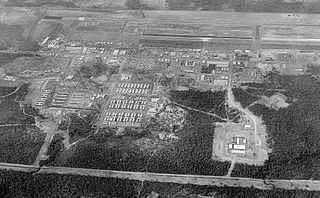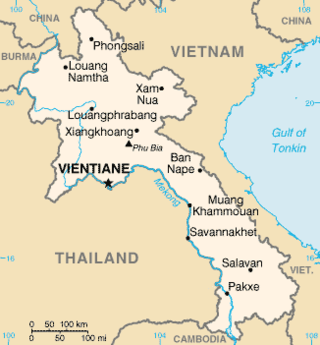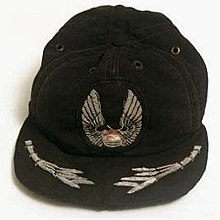
The Laotian Civil War (1959–1975) was a civil war in Laos waged between the Communist Pathet Lao and the Royal Lao Government from 23 May 1959 to 2 December 1975. It is associated with the Cambodian Civil War and the Vietnam War, with both sides receiving heavy external support in a proxy war between the global Cold War superpowers. It is known as the Secret War among the American CIA Special Activities Center, and Hmong and Mien veterans of the conflict.
The Royal Lao Air Force, best known to the Americans by its English acronym RLAF, was the air force component of the Royal Lao Armed Forces (FAR), the official military of the Royal Lao Government and the Kingdom of Laos during the Laotian Civil War between 1960 and 1975.

Air America is a 1990 American action comedy film directed by Roger Spottiswoode and starring Mel Gibson and Robert Downey Jr. as Air America pilots flying missions in Laos during the Vietnam War. When the protagonists discover their aircraft is being used by government agents to smuggle heroin, they must avoid being framed as the drug-smugglers.
Civil Air Transport (CAT) was a Nationalist Chinese airline, later owned by the U.S. Central Intelligence Agency (CIA), that supported United States covert operations throughout East and Southeast Asia. During the Cold War, missions consisted in assistance to "Free World" allies according to the Mutual Defense Assistance Act of 1949.
Edgar "Pop" Buell was a humanitarian aid worker in Laos. He was a farmer in Steuben County, Indiana, until the age of 47, but following the death of his wife in 1958 he joined the International Voluntary Services, a precursor to the Peace Corps, which offered him a job as an agricultural adviser in Laos. Buell worked in Laos through the Laotian Civil War, organizing relief aid to refugees and isolated villages. He was forced to flee Laos in 1974 when the Communist Pathet Lao gained control of the country.

The United States Central Intelligence Agency (CIA) has been accused of involvement in the trafficking of illicit drugs. Books and journalistic investigations on the subject that have received general notice include works by the historian Alfred McCoy, professor and diplomat Peter Dale Scott, journalists Gary Webb and Alexander Cockburn, and writer Larry Collins. These claims have led to investigations by the United States government, including hearings and reports by the United States House of Representatives, Senate, Department of Justice, and the CIA's Inspector General. The various investigations have generally not led to clear conclusions that the CIA itself has directly conducted drug trafficking operations, although there may have been instances of indirect complicity in the activities of others.

The Nakhon Phanom Royal Thai Navy Base (NKP), formerly Nakhon Phanom Royal Thai Air Force Base, is a Royal Thai Navy facility used for riverine patrols along the Mekong River. It is approximately 587 km (365 mi) northeast of Bangkok, 14.5 km (9.0 mi) west of Nakhon Phanom city in Nakhon Phanom Province in the northeastern region of Thailand, and 411 km (255 mi) from Hanoi in Vietnam. The Mekong River is NKP's border with Laos. The airfield at NKP is jointly used as a civilian airport.
Udorn Royal Thai Air Force Base is a Royal Thai Air Force (RTAF) base, the home of 23rd Wing Air Command. It is in the city of Udon Thani in northeastern Thailand and is the main airport serving the city and province.

Operation Barrel Roll was a covert U.S. Air Force 2nd Air Division and U.S. Navy Task Force 77, interdiction and close air support campaign conducted in the Kingdom of Laos between 14 December 1964 and 29 March 1973 concurrent with the Vietnam War. The operation resulted in 260 million bombs being dropped on Laos.

Relations between Laos and the United States officially began when the United States opened a legation in Laos in 1950, when Laos was a semi-autonomous state within French Indochina. These relations were maintained after Laos' independence in October 1953.
CIA activities in Laos started in the 1950s. In 1959, U.S. Special Operations Forces began to train some Laotian soldiers in unconventional warfare techniques as early as the fall of 1959 under the code name "Erawan". Under this code name, General Vang Pao, who served the royal Lao family, recruited and trained his Hmong and Iu-Mien soldiers. The Hmong and Iu-Mien were targeted as allies after President John F. Kennedy, who refused to send more American soldiers to battle in Southeast Asia, took office. Instead, he called the CIA to use its tribal forces in Laos and "make every possible effort to launch guerrilla operations in North Vietnam with its Asian recruits." General Vang Pao then recruited and trained his Hmong soldiers to ally with the CIA and fight against North Vietnam. The CIA itself claims that the CIA air operations in Laos from 1955 to 1974 were the "largest paramilitary operations ever undertaken by the CIA."

The Royal Lao Armed Forces, best known by its French acronym FAR, were the official armed defense forces of the Kingdom of Laos, a state that existed from 1949 to 1975 in what is now the Lao People's Democratic Republic. First created under the French protectorate of Laos on July 1, 1949, the FAR was responsible for the defense of the Kingdom since its independence in October 1953 from France, until its dissolution on December 2, 1975. It operated notably during the North Vietnamese invasion of Laos and the Laotian Civil War from 1960 to 1975.

The Laotian Civil War was a military conflict that pitted the guerrilla forces of the Marxist-oriented Pathet Lao against the armed and security forces of the Kingdom of Laos, led by the conservative Royal Lao Government, between 1960 and 1975. Main combatants comprised:
William Young was a Central Intelligence Agency paramilitary officer born in Berkeley, California and raised in Burma and Thailand. Although he was Caucasian, he was reared in the local hill tribe culture. Because his father and brother already worked for the CIA and knew Bill Lair, the Agency knew of his extensive cultural contacts with the Lahu people and other Southeast Asian hill tribes. With command of several Asian languages, he was made a natural recruiter of local guerrillas for the CIA's covert operations in the secret war in the Kingdom of Laos. He was then considered for the position of case officer to the Hmong Vang Pao. He was passed over in favor of sending him on an extended reconnaissance of the Kingdom of Laos. His tour ranged westward from his start at Long Tieng, which he reported as well sited for operations in the Plain of Jars, back to familiar territory in the Golden Triangle.
The Battle of Luang Namtha, fought between January 1962 and May 1963, was a series of clashes in the Laotian Civil War. It came about as a result of the turmoil following Laotian independence as a result of the First Indochina War with France. The Kingdom of Laos had foreign soldiers on its soil, and a political struggle in progress concerning those outside troops. Following a coup and counter-coup that left General Phoumi Nosavan in charge, the general decided on military action to settle the political issue of interlopers in Laos.
Operation Millpond, which operated from 13 March 1961 through August 1961, was an American covert operation designed to introduce air power into the Laotian Civil War. A force of 16 B26s, 16 Sikorsky H-34s, and other military materiel was hastily shipped in from Okinawa and held ready to operate from the Kingdom of Thailand. After this hasty preparation for bombing in Laos, the debacle at the Bay of Pigs invasion resulted in the cancellation of Millpond. The B-26s were returned to Okinawa. However, the precedent had been set for covert Central Intelligence Agency-sponsored air operations in Laos.
The raid onBan Naden of 9 January 1967 was a successful rescue of prisoners of war during the Vietnam War. The raid was improvised after local Central Intelligence Agency officers induced a Pathet Lao deserter to lead a rescue party back to the prison camp. At about 0400 hours on 9 January 1967, a raiding party of 10 Lao mercenaries led by Sergeant Te killed or dispersed the communist guard force, only to discover twice as many rescuees as they had counted upon. Some of the captives immediately returned to their local homes, while the others followed their rescuers to an impromptu pickup zone in the midst of the Ho Chi Minh Trail. Hastily summoned Air America helicopters retrieved the raiders and the remaining prisoners, one of whom was Phisit Intharathat.

The 1967 Opium War took place in northwestern Laos between February and August 1967; actual fighting took place from 29 July to 1 August 1967. A mule train, led by Burmese militia, carrying 16 tons of opium crossed into Laos to Ban Khwan, where they were attacked by rival drug smugglers from the Chinese Nationalists' Third and Fifth Armies. The intended recipient of the shipment, Royal Lao Army General Ouane Rattikone, bombed both sides while moving in troops to sweep the battlefield. With both Burmese militia and Nationalist Chinese defeated and expelled from Laos, the Lao general confiscated the opium for himself.
Project Waterpump was a secretive support operation by the U.S. Air Force to train and nurture into existence the Royal Lao Air Force (RLAF). The United States had decided to covertly support the Kingdom of Laos in the Laotian Civil War as the Lao fended off a North Vietnamese invasion. The nascent RLAF was seen as a force multiplier but needed pilots and technicians. The 40-man Detachment 6, 1st Air Commando Wing, code named Waterpump, was forwarded to Udorn Royal Thai Air Force Base for this training duty in March 1964. They would remain on duty through the truce of 21 February 1973. Their first hasty assignment was transition training to the T-28 Trojan for American civilian pilots; the resulting A Team would exist through 1967. The Air Commandos also conducted final training for Royal Thai Air Force (RTAF) mercenary pilots; the resultant B Team would serve until 1970. Besides putting a polish on graduate pilots, the Waterpump detachment trained Lao pilots from scratch. The RLAF's high pilot casualty rate made bringing the RLAF rosters up to strength a long grind.
The Chinese Road were a series of highways built as a foreign aid project by the People's Republic of China (PRC) in northern Laos, beginning in 1962. The first new road was built from Mengla, Yunnan Province, PRC to Phongsali, Laos; it was completed on 25 May 1963. The next major road built was Route 46, begun in the 1966 dry season and stretching from the southern tip of Yunnan Province southward toward the border of the Kingdom of Thailand. As 25,000 Chinese troops and 400 antiaircraft guns came to be posted to defend Route 46, and Thai support of American war efforts in both the Laotian Civil War and the Vietnam War became widely known, there was uneasiness among both Thai and American intelligence communities concerning Communist China's intents in constructing the all-weather highway. American interest in the new road extended up to the White House.














